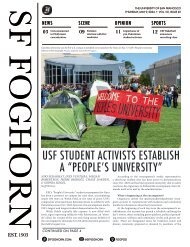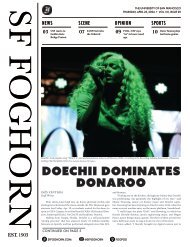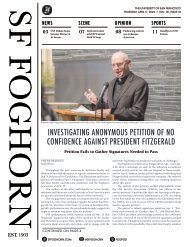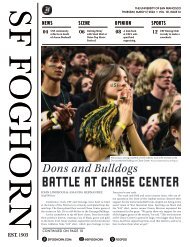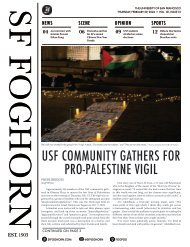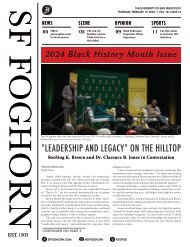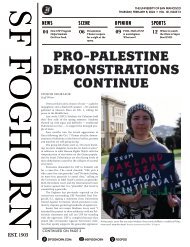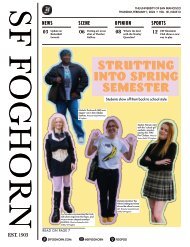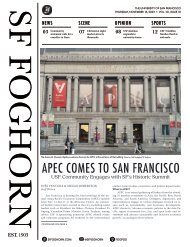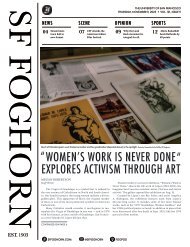Create successful ePaper yourself
Turn your PDF publications into a flip-book with our unique Google optimized e-Paper software.
06 07<br />
THURSDAY<br />
APR. 18<br />
2024<br />
HAUTE COUTURE with a side of<br />
AUGMENTED REALITY<br />
A Century of San Francisco Style at the de Young<br />
earth month spotlight<br />
HIGH-END FASHION IS A HOAX!<br />
SCENE<br />
ELINA GRAHAM<br />
Staff Writer<br />
The recognizably dreamy notes of Glenn Miller’s “Moonlight Serenade”<br />
played as viewers gazed upon mannequins modeling a range of<br />
designs in the de Young museum’s latest exhibition, “Fashioning San<br />
Francisco: A Century of Style.”<br />
This exhibition explores the evolution of women’s fashion in San<br />
Francisco by highlighting legendary collections and designers of the<br />
20th and 21st centuries. According to their website, this is the museum’s<br />
“first major presentation of [their] costume collection in over 35<br />
years.” In addition to Christian Dior, Comme des Garçons and Vivienne<br />
Westwood, more than fifty designers’ works are on display — for<br />
many pieces, this is their first showing.<br />
“‘Fashioning San Francisco’ is a rich presentation that asserts the<br />
case that San Francisco does, and has always had, style,” stated Thomas<br />
P. Campbell, director and CEO of the Fine Arts Museums of San<br />
Francisco in a press release.<br />
The exhibit also collaborated with Snapchat’s parent company,<br />
Snap Inc., to invite viewers to use augmented reality (AR) to see themselves<br />
in this historical legacy.<br />
Greeting visitors as they entered the room, a<br />
mannequin was dressed in Jeanne Lanvin’s “Veilleur<br />
de Nuit” evening gown of the Spring/Summer<br />
<strong>19</strong>24 collection. With a dropped waist and a full,<br />
calf-hitting skirt evocative of the 18th century,<br />
this hundred-year-old “robe de style” has a<br />
silhouette Lanvin popularized in the<br />
<strong>19</strong>20s.<br />
Further down the narrow<br />
halls of the exhibit is a room devoted<br />
entirely to shoes. From the<br />
<strong>19</strong>98 patent Prada Mary Janes,<br />
to Rei Kawakubo’s embroidered<br />
leather “Cut Out Cowboy” design<br />
from the <strong>19</strong>99 Fall/Winter<br />
collection, many styles have once<br />
graced the streets of San Francisco.<br />
The main exhibition wing featured<br />
styles ranging from experimental clothing<br />
to suitwear, including Richard<br />
Tam’s ostrich-feather headdress, mask<br />
and fan that accompanied a printed<br />
paisley silk Valentino evening gown,<br />
and a honeycomb inspired jacket<br />
designed by Junya Watanabe for<br />
Comme des Garçons in 2015.<br />
Many of these pieces<br />
were gifted to the museum<br />
by San Francisco<br />
philanthropists<br />
and fashionistas.<br />
Christine Suppes,<br />
author and founder of digital couture publication Fashionlines,<br />
donated more than 500 articles of clothing to the museum. Suppes<br />
wore many of the ensembles to black-tie galas and balls.<br />
“‘Junon’ and ‘Venus’, the two Dior ball gowns, stood out to me for<br />
sure,” said junior media studies student Alley Garland, whose interest<br />
in high fashion brought her to the exhibition. “They were absolutely<br />
stunning and it was incredible to look at all of the beading and detail<br />
gone into every part of each dress.” These pieces were found in the<br />
formalwear section, among other couture gowns by the likes of John<br />
Galliano for Christian Dior and Karl Lagerfeld for Chanel.<br />
Outside of the main showing room was a wing dedicated to the<br />
“Little Black Dress” design, known in the fashion world as a staple in<br />
a woman’s wardrobe. The term now suits a range of styles, as seen by<br />
the distinctive and unique dresses on display, including the black silk<br />
velvet “Soirée de Paris” gown designed by Yves Saint Laurent while he<br />
worked for Christian Dior. This gown was available to virtually try on<br />
in the exhibit’s special augmented reality (AR) room post-exhibition<br />
viewing.<br />
Similar to how Snapchat filters work, a viewer could stand in<br />
front of one of three mirrors and virtually try on three iconic designs<br />
by Yves Saint Laurent, Kaisik Wong and Valentino. The real works<br />
were all on display upstairs, but this installation gave museum-goers<br />
the opportunity to snap a photo in a designer gown.<br />
Junior media studies student Ella Brohm said<br />
“I thought the [AR] was kind of a weird addition.”<br />
On the other hand, Garland enjoyed the installation.<br />
“The AR experience was so fun! It was a little silly<br />
but my sister and I laughed the whole time and took<br />
a bunch of photos,” she said.“ I thought it was nicely<br />
done and it actually looked like we were wearing<br />
the clothing. It’s definitely the closest I’ll ever<br />
get to wearing haute couture.”<br />
“I hope visitors see the impact that women’s<br />
fashion has had on society,” Garland continued.<br />
“You can see the evolution of fashion<br />
simply through the complexity, form and use<br />
of color in them. Fashion is a huge part of expression<br />
and these designers capture a wide<br />
range of femininity that is really neat.”<br />
Fashioning San Francisco: A Century<br />
of Style is on display at the de Young<br />
museum through August 11. Tickets<br />
can be purchased on the museum’s<br />
website, students can get a discounted<br />
ticket with valid student ID.<br />
Editor-in-Chief: Megan<br />
Robertson, Chief Copy Editor:<br />
Sophia Siegel, Managing Editor:<br />
Jordan Premmer, Scene<br />
Editor: Inés Ventura<br />
While the exhibit is centered around historical fashion, it also showcased more contemporary pieces, like Edwin Oudshoorn’s Spring/Summer 2020 Spellbound gown with<br />
detached sleeves and pin. Photo by Samantha Elina Graham/SF Foghorn<br />
According to the SF Museum of Fine Arts’ Textile and Conservation Lab, each of the tens of thousands of sequins seen on the Dior “Venus” gown (seen above) are individually<br />
swabbed as part of their conservation practice. Photo by Samantha Elina Graham/SF Foghorn<br />
REMI BRANDLI is a junior<br />
media studies major.<br />
High-end fashion brands are<br />
aligning themselves with social<br />
movements to attract larger audiences,<br />
yet their output is insulting to the<br />
communities they are supposedly<br />
representing. While major brands<br />
receive attention and money, true<br />
activists fight for a level playing field.<br />
We as consumers must divert<br />
our attention and money from<br />
corporations that are: reinforcing<br />
racist tropes, destroying the<br />
environment, and doing so all<br />
the while claiming to be forwardthinking.<br />
RACIST TROPES<br />
According to brand executives<br />
themselves, Banana Republic was<br />
initially created as an imagined, exotic place, “like Shangri-La, Middle<br />
Earth, Westeros, or Wakanda,” as stated in their 2021 rebrand campaign.<br />
The inspirations and descriptors of the new fashion line included<br />
aesthetics such as “safari meets tuxedo,” according to the brand. Even<br />
Banana Republic’s name is rooted in the colonization of Latin American<br />
and African countries according to Fast Company. The fetishized appeal<br />
of the “safari” seeps from the dark history of imperialism into the modern<br />
day.<br />
In their 2024 advertising, you will find only two Black models and<br />
two Asian models sandwiched between their five white counterparts—a<br />
lacking attempt at promoting racial diversity. Companies are utilizing<br />
these models merely to place them in an imagined exotic world, tokenizing<br />
them based on their race.<br />
It extends beyond Banana Republic. De Beers Jewellers tokenized<br />
Lupita Nyong’o, a Mexican-Kenyan actor, as a model for their “Where it<br />
Begins” campaign. The name of said campaign is “a visual nod to De Beers’s<br />
South African origins … and ongoing mining activities in Botswana,<br />
Namibia, and South Africa,” states Nancy Friedman in an article exploring<br />
the company’s history. Notably, none of those countries are Kenya.<br />
LACK OF TRANSPARENCY<br />
The De Beers Diamond Co. and Marc Jacobs neglect to<br />
consistently update their codes of ethics in terms of resource<br />
extraction. Both companies follow the UK Modern Slavery Act,<br />
as posted on their websites under their codes of ethics. The 2015<br />
legislation aims to make provisions “about slavery, servitude and<br />
forced or compulsory human labour and about human trafficking,”<br />
according to the bill.<br />
While adhering to this legislation is admirable, it is not enough<br />
to claim compliance and then not consistently update consumers<br />
on ethical sourcing of materials in areas known to exploit laborers.<br />
Recent updates regarding these brands’ ethics are not available. De<br />
Beers’ last statement was in 2022, and Marc Jacobs’ was in 2018.<br />
ENVIRONMENTAL IMPACT<br />
While sustainability in fashion can be possible, current<br />
industry business models are resistant to it. The industry’s lack of<br />
transparency makes assessing sustainability difficult. According to<br />
the Harvard Business Review of unsustainable fashion practices,<br />
most corporate social responsibility reports “do not accurately<br />
quantify the full carbon emissions profile of fashion brands.”<br />
Further, attempts at sustainable fashion have struggled in the<br />
existing business models which prioritize rapid-consumerism..<br />
The McKinsey Global Fashion Index has tracked “a burst<br />
of pent-up consumer demand,” boosting global industry revenues up<br />
between 6-21% in the years 2021 and 2022. This boost is paralleled by<br />
the rise in the fashion industry’s “carbon impact range” by 6%, according<br />
to the Harvard Business Review. While corporations continue to prosper,<br />
our planet is dying in the name of trends.<br />
DIVESTMENT<br />
We must boycott brands that preach values of transparency they do<br />
not practice, brands that exoticize and fetishize models as representation<br />
and diversity, and brands that put money towards the oppression of other<br />
humans. Luckily there are tools to help us with this.<br />
One of my go-to models for sustainable consumerism is Nabihah<br />
Ahmad. A student at Columbia University, Ahmad is a “Bangladeshi-<br />
Muslim American from Queens, NY,” as described in her Instagram post.<br />
Her startup, SSQRD, is focused on remodeling modern fashion and hosts<br />
the website Ethos, which filters for ethical brands and products.<br />
Functioning under values of transparency and community, the<br />
startup is “a movement aimed at breaking down the barriers created by<br />
traditional corporations,” according to the Ethos website. Ahmad comes<br />
from a family of garment workers in Bangladesh, and is motivated to<br />
create change on behalf of her family.<br />
With a wide list of fashion, skincare, makeup and fragrances, many<br />
products are tagged as “Black-owned,” “Palestinian owned,” or other<br />
notable identifiers, encouraging consumers to support sustainable<br />
businesses and marginalized business owners.<br />
There is an added layer of transparency with the “Caution” label,<br />
identifying products and brands with problematic elements, such as alleged<br />
forced labor practices and fiscal support of Israel. Ethical consumption<br />
of fashion and beauty is possible, by supporting transparent, ethical<br />
brands and entrepreneurs. Ahmad is just one example of fashion moguls<br />
whose values align with the greater community. SSQRD is a great way to<br />
promote and support brands and businesses that operate on humanitarian<br />
principles, not just profit.<br />
Editor-in-Chief: Megan Robertson, Chief Copy Editor: Sophia<br />
Siegel, Managing Editor: Jordan Premmer, Opinion Editor: Chisom<br />
Okorafor<br />
Graphic by Mariam Diakite/Graphics center<br />
OPINION




